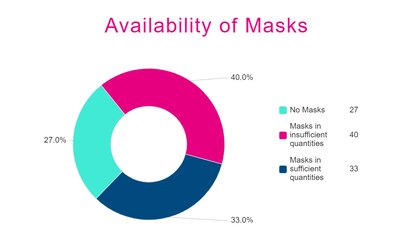MENAPOL Blog
Economic Priorities Post-Covid in Morocco

In light of the crisis of uncertainty COVID19 has ignited, we are today ahead of an unprecedented economic crisis in Morocco with irreversible impacts on all levels. The Moroccan economy recorded a -1,8% shrink in the second season of 2020 versus a 1,1% growth in the first season.
The country also recorded a 3,5% slip in foreign demand. The exports dropped by 22,8%; the import of merchandises has known a 4,8 drop in the first season of 2020. In sum, all economic activities got a hit. The question to ask today therefore is what solutions to implement for an economic rebound in Morocco?
This article will try to measure the strength of the Moroccan economic, financial and social links at the dawn of COVID19 and to propose potential solutions to path the way for a prompt recovery of the kingdom’s economy post-crisis. The article draws its content from an online debate organized by DAMIR Mouvement in partnership with FNF Morocco in May on “The Economic Priorities post-COVID”, with the presence of Mr Mohammed Benmoussa and Abdelilah Doumou, both Moroccan economists.
1. Neither Demand Nor Supply:
The Economic particularities of the crisis
This crisis draws particularities on several plans, first and for the first time, neither demand nor supply influenced this economic crisis. It is a simultaneous shock of both at the same time. In other words a brutal shift of all world flows.
Secondly, the treatment of this crisis’ symptoms in particular is contradictory. In fact, if we opt for health priority this encourages lockdown, which in turn generates a cessation of economic activity. In the event of an economic recovery, there is the risk of the virus spread.
The third aspect is that the world economy will no longer be a unipolar body and would rather become based on the primacy of proximity, which will create three economic poles, namely: China, the United States and Europe, which should now know a new dynamic of cooperation aiming to create more balance between the north and the south.
On the fourth level, this is a crisis of sovereignty and dependence, affirmed by the global problem of masks and respirators in the early stages of the crisis. Finally, it is a crisis of representation in the democratic system, vis-à-vis growing social protests and the decline of traditional mediation structures (political parties and unions), to the detriment of the primacy of social networks and direct intervention of citizens to influence national systems.
In light of these various particularities, this multidimensional crisis draws its response from multidimensional, visionary, concerted solutions useful for the management of public policies on a planetary level as was the case for decades back in the aftermath of the crash of 1929 (e.g. creation of the G20), while counting on a global awareness and a shared sense of responsibility.
2. Macroeconomic Response to the Covid-19 Crisis on Morocco and its social impact
2.1 Morocco's response to the COVID-19 Crisis on a macroeconomic level (31:00 min – 36:50 min)
According to Mr. Benmoussa, the Management of the crisis in Morocco should be analyzed as follow:
Morocco must act through a three-step response: first, the management of the economic and social crisis during the lockdown, then the preparation for the resumption of economic activities with appropriate public policies, and finally the management of economic recovery and development plans in the medium and long-term.
The measures taken in the period of lockdown revolve around the launch of a special pandemic management fund, which has mobilized broad national solidarity and gathered over 32.5 billion Moroccan dirhams, through the contribution of public institutions, private companies, ministries, professional organizations, civil society, private benefactors, etc.
The fund covered the need for medical equipment and supplies for the Ministry of Health and helped support the most vulnerable households and the most fragile enterprises (950.000 employees in 134 companies registered in social security, 7 Million Households working in the informal sector, of which 3 Million aren’t even registered in the medical assistance program.)
The State has also launched a series of measures: including loan maturity deferral, the implementation of support credits State-guaranteed via the Central Guarantee Fund (17,000 companies have benefited from nearly 10MMDH through Daman Oxygen), cut of the base interest rate, widening of refinancing possibilities for banks to support SME.
In addition to the activation of a precautionary line with the International Monetary Fund of 3MM (allocated to the central bank in order to support the foreign exchange reserve and maintain of the value of our national currency), as well as the acceleration of public debts payments to SMEs and the postponement of delivery dates in public markets. Finally, the development of the economic recovery strategy by the economic watch committee.
Despite these efforts however, the measures taken are very limited in light of the current stales, as the concern is the disintegration of the economic fabric after the lockdown (in light of e.g. the SMEs in bankruptcy due to this brutal halt of activity). Therefore, the priority of public policies must be to maintain our economic fabric and safeguard it by means of state intervention, focusing mainly on the maintenance of our productive capacity and the protection of our SMEs fabric.
2.2 Impact of Morocco's response to the COVID-19 Crisis on the social level
Overall, it is important to emphasize the responsiveness of public authorities in an early and proactive manner. However, at this point it is difficult to evaluate the damage, which is progressive and variable according to the evolution of the pandemic and our coexistence with this virus. On the social level whatever the efforts, there is an imprecision in the extent of the prejudices and damages on the economic response, affirmed by Mr. Doumou.
In fact, according to Morocco’s High Commission for Planning:
- 34% of households have no source of income due to the lockdown
- 49% of households have at least one worker who lost their job due to the lockdown
- Only 6% of households receive help from the state at the national level
- 59% of households expressed their requests but did not receive public aid
- 51% of households did not follow distance e-leaning courses due to the absence of access channels to the course (internet and equipment).

In terms of protection measures:
- 40% of households attest that they do not find masks in sufficient quantities
- 27 % do not find masks at all
- Only 33% find masks in sufficient quantities.

In addition, one in two households in Morocco (51%) does not have disinfectant products. The situation is more alarming in rural areas, with a rate reaching 70%.
3. Prospects and solutions for post-COVID-19 in Morocco
The COVID crisis is attacking the foundations of the economic and social structure of the country and despite its efforts; Morocco needs to rethink its economic strategies. Therefore, the discussion of a recovery economy plan is premature. Indeed, it is first necessary to preview a period of survival and convalescence of at least two years, taking into account the prejudices of the crisis and the probable duration of cohabitation with the virus, which means that a revival is conditioned by the start of the world trade production.
Morocco in the last two decades having adopted expansionist policies based on the growth of public investment and the establishment of sectoral financing funds aimed at developing economic activity within companies in several sectors, finds itself at the quid of the need to carry out structural reforms on several strategic levels with an iron arm.
Today, the kingdom needs to first work on resetting its sectorial priorities while improving its finances, through the creation of a Public Investment Bank (PIB) or even regional PIBs in the service of the State's industrial strategy and its support, to launch a better revitalization of the Moroccan-banking sector while improving monetary policies in parallel.
It is also mandatory to reinvent the Moroccan economic market, by fostering a favorable space for business development in terms of laws (crowdfunding, social Enterprises), support mechanisms (subsidies) and products’ consumption and export (Made in Morocco labels) by encouraging an internal market to exceed the limits of dependence on importations.
This crisis is a blessing that also enables the country to Fulfill the role of a production site close to Europe and a destination of global value chains’ relocation, which will allow Morocco to easily re-conquest export markets post-pandemic.
Conclusion
Finally, the reactivity of Morocco towards the COVID crisis as it appears had a policy of double trigger reaction, a rapid and agile proactive trigger on the management of the health and security risk of the pandemic but a much more conservative trigger on the economic and social aspects.
The main budgetary effort provided is the special COVID fund equivalent to 3.2% of GDP, which remains very far below the need in order to reinvent our economy, affirmed by the numbers.
This exceptional situation calls for exceptional measures not only at the political level but also by the necessary political leadership to pursue bold decisions in these times of crisis with clear vision despite the uncertainties.
Finally, not all these strategies would be successful unless Morocco succeeds in mobilizing a kind of collective intelligence, which symbolizes the strength of democracy, and the necessity of militating to strengthen Morocco’s democratic system, which has not yet reached the level, aspired, to become a vector of progress.
About the Author

